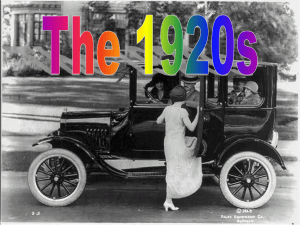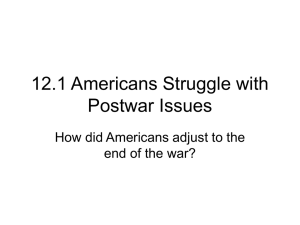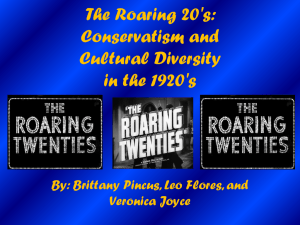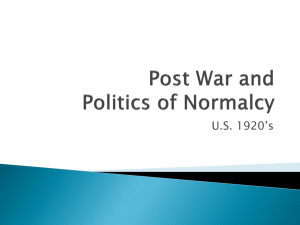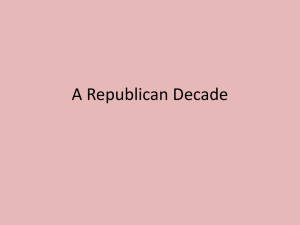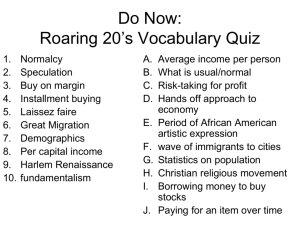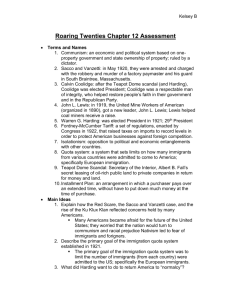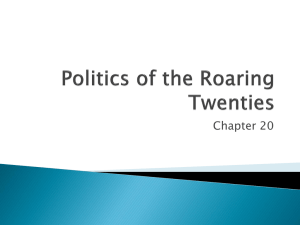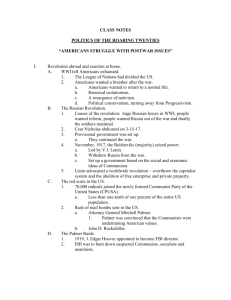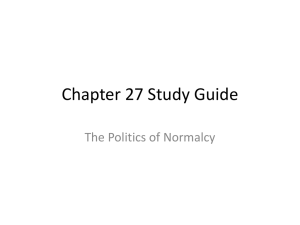Politics of the Roaring Twenties
advertisement
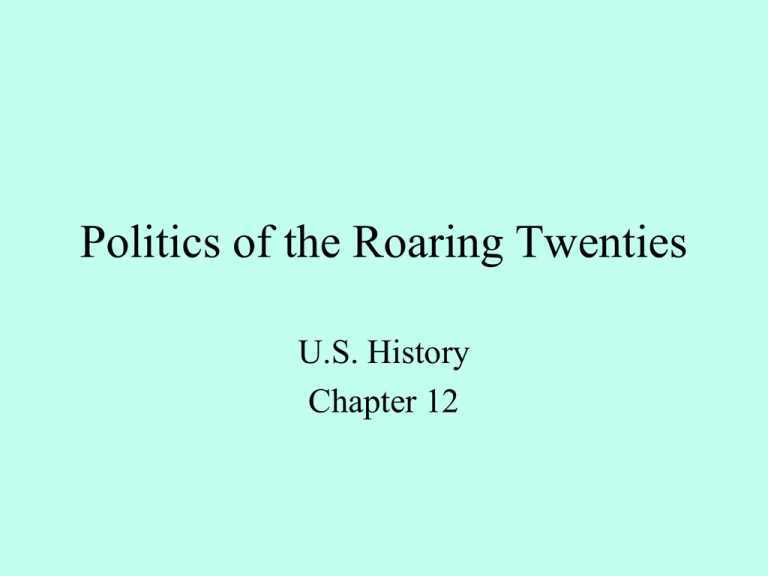
Politics of the Roaring Twenties U.S. History Chapter 12 Postwar Problems Divided America over League of Nations Progressive Era led to changes in American life Economy adjusting back to consumer goods Soldiers returning to unemployment, readjustment to life Cost of living doubled Work orders for factories and farmers dramatically reduced • Many began to fear outsiders. Led to an increase in nativism • Many people pushed for isolationism – pulling away from involvement in world affairs. Fear of Communism • Communism – economic and political system based on a single party government ruled by a dictatorship. – Put an end to private property, government ownership of factories, RR, other businesses. The Red Scare • Russian revolution led to panic – “Reds” in Russia - worldwide revolution. • Communist party formed in the US – 70,000 members. – Bombs mailed to government and business leaders. • Public became scared – Red Scare. • U.S. Attorney General – Mitchell Palmer. The Palmer Raids • Hunted down suspected communists and anarchists – people who opposed any form of government. • No evidence of any conspiracy Sacco and Vanzetti • Italian immigrants - anarchists • Arrested and charged with robbery(stole over $17,000) and murder of factory paymaster and his guard. – Provided alibis and said they were innocent • Jury – guilty, sentenced them to death. • Led to protests around the world. Many thought they were sentenced b/c of their radical beliefs/immigrants. • They died in the electric chair. Limiting Immigration • Need for unskilled labor had decreased, so need for immigrants decreased. Nativism increased. • Immigrants – seen as radicals and anarchists. • Ku Klux Klan - Devoted to “100% Americanism.” – Anti Everything - against blacks, saloons, unions, Catholics, Jews. Anti-foreign, anti-Catholic, antiblack, anti-Jewish, anti-pacifist, anti-communist, antiinternationalist, anti-evolutionist, anti-bootlegger, antigambling, anti-adultery, and anti-birth control. It was pro-Protestant, pro-Anglo-Saxon, pro-“native” American. • 1919 – 1920 - # of immigrants increased 600%. • Emergency Quota Act of 1921 – quota system – maximum number of people who could enter the U.S. from each foreign country. – Goal – cut down dramatically the # of people coming from Europe. • 1924 – 2% of # living in the U.S. in 1890. – discriminated against Catholics and Jews. • Prohibited Japanese immigration – led to ill will between the U.S. and Japan. • Did NOT apply to the Western Hemisphere Mexico and Canada increased a lot. A Time of Labor Unrest • War – no strikes. 1919 – 3,000 strikes due to no wage increases, refusal to allow workers to join unions (employers determined to halt war-time gains). • The Boston Police Strike • The Steel Mill Strike • The Coal Miner’s Strike • Propaganda used to link strikers to communism. Section 2 The Harding Presidency “Return to Normalcy” Harding Struggles for Peace • Sec. of State – Charles Evans Hughes • Washington Naval Conference –major European powers, except Russia (communism), invited to Washington. – No more warships to be built for 10 years, 5 major powers (U.S., BR, FR, Japan, and Italy) will reduce battleship tonnage, cruisers, and aircraft carriers. • Kellogg-Briand Act – renounced war as a national policy. Couldn’t enforce though, so really didn’t work! We can reduce our military. High Tariffs and Reparations • FR and GB owed the U.S. $10 billion. Needed to get the money from Germany. – Worried that there would be a flood of cheap goods from recovering Europe, businesses wanted to put a wall of protection around the U.S. • Fordney-McCumber Tariff – raised tariffs to 60%. Made it impossible for FR and GB to sell goods to the U.S., therefore making it hard for them to raise money to pay us back. • They looked to Germany and their reparations. Germany couldn’t pay • Dawes Plan - scaled back war debt and reparations to $250 million/year (would increase as German economy improved) • $200 million in loans - money paid to G.B. and France in reparations payments. The money would then come to the U.S. as war debt payments (This will end with the crash in 1929). • The U.S. never did get it money, but it harvested a bumper crop of ill will from the French. Scandal Hits Harding’s Administration • Warren G. Harding elected in 1920 • laissez-faire • Harding had few qualifications for the presidency. He was in the Senate, but only because political machine put him there. Same for President – they wanted someone they could control. • “Ohio Gang” - close group of friends • Cabinet members – Sec. of Commerce – Herbert Hoover, Sec. of State – Charles Evans Hughes, Sec. of Treasury – Andrew Mellon, Attorney General – Harry Daugherty. • Charles Forbes – director of Veterans Bureau – went to prison for swindling the government out of $200 million in hospital supplies. • Attorney Gen. Harry Daugherty – faced two criminal trials for bribery (illegal sale of pardons and liquor permits), but burned incriminating documents and did not go to jail. The Teapot Dome Scandal • Secretary of Interior Albert Fall leased critical government oil reserves to two private oil companies • Fall received illegal payments and so-called loans that totaled over $300,000 • Went to jail • WGH depressed, suffered a heart attack in 1923, and died. VP Calvin Coolidge became president. Section 3 The Business of America • Calvin Coolidge –taxes low, business profits up, give businesses more credit to expand. • Increased tariffs, reduced income taxes so people would spend more money. • Coolidge – supported business!!!! The Impact of the Automobile • 1920 – 8 million on the roads. By 1929 – 27 million. • Paved roads –Route 66 – • Architectural styles changed – Houses now had driveways with garages/carports. • New businesses – gas stations, repair stations, motels, tourists attractions, shopping centers. • Tunnels – 1st one – Holland Tunnel – NYC to NJ. • Brought rural people to the cities. • Vacations • Independence for the young • Urban sprawl – spread out of the cities. Route 66 – Chicago to California America’s Standard of Living Soars • Annual income rose 35%. • Electricity spreading over bigger distances. # of houses with electricity increasing. Mid 20s – 60% of nation’s homes wired for electric power. – Irons, refrigerators, ranges, toasters – freed women to do other things. • Advertising - Played on people’s conscience – Targeted middle class women the most. Buying Goods on Credit • Easy credit – installment plan – buy goods over an extended period of time with a low interest rate. • By 1930 – 15% of all purchases were made on installment plans
